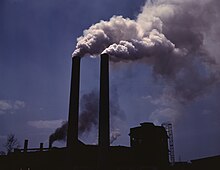Urban ecology
In the nineteenth century, naturalists such as Malthus, De Candolle, Lyell, and Darwin found that competition for resources was crucial in controlling population growth and is a driver of extinction.
In contrast, Costa Rica's LEU holds distinction as the world's first research center exclusively devoted to studying tropical urban ecosystems.
These long-term data sets can then be analyzed to find trends relating to the effects of the urban environment on various ecological processes, such as species diversity and abundance over time.
[21] There are currently two active urban LTERs: Central Arizona-Phoenix (CAP), first launched in 1997 and housed at Arizona State University[22] and Minneapolis-St. Paul Metropolitan Area (MSP).
Urbanization was driven by migration into cities and the rapid environmental implications that came with it; increased carbon emissions, energy consumption, impaired ecology; all primarily negative.
Cities are home to an abundant amount of financially well-off, knowledgeable and innovative initiators who are increasing the involvement of science in urban policy processes and concepts.
The intersection of the multiple processes/integrated systems approach which can easily emerge within a city, includes five characteristics that can emphasize this fundamental shift at a low cost.
They take into account the chemical, biophysical, and ecological aspects that define urban systems, including lifestyle choices that are interlinked with the culture of a city.
Carbon dioxide emissions from the transport of goods also contribute to accumulating greenhouse gasses and nutrient deposits in the soil and air of urban environments.
Introduced or alien species are populations of organisms living in a range in which they did not naturally evolve due to intentional or inadvertent human activity.
[30] Invasive species are successful when they are able to have proliferate reproduction due to short life cycles, contain or adapt to have traits that suit the environment and appear in high densities.
[33] In New York City a genetic study exploring genome wide variation concluded that multiple rats were originally from Great Britain.
[17] Furthermore, natural biogeochemical cycles in the urban environment can be impeded due to impermeable surfaces that prevent nutrients from returning to the soil, water, and atmosphere.
In addition, nitrogen and phosphorus used in fertilizers have caused severe problems in the form of agricultural runoff, which alters the concentration of these compounds in local rivers and streams, often resulting in adverse effects on native species.
[17] Urban environments and outlying areas have been found to exhibit unique local temperatures, precipitation, and other characteristic activity due to a variety of factors such as pollution and altered geochemical cycles.
Brazel et al.[21] found that the urban heat island effect demonstrates a positive correlation with population density in the city of Baltimore.
In 1896, Swedish scientist Svante Arrhenius established that fossil fuels caused carbon dioxide emissions (the most abundant and harmful greenhouse gas) .
The excessive emission of greenhouse gases is responsible for much of the harm that can be observed today including global warming, respiratory diseases due to pollution, extinction or migration of certain species, etc.
Processes related to urban areas result in the emission of numerous pollutants, which change corresponding nutrient cycles of carbon, sulfur, nitrogen, and other elements.
These effects have been observed in vertebrates and invertebrates while plant species tend to increase with intermediate-low levels of urbanization[52][53] but these general trends do not apply to all organisms within those groups.
Natural and financial resources are limited; a larger focus must be placed on conservation opportunities that factor in feasibility and maximization of expected benefits.
[66] Since the securing of land as a protected area is a luxury that cannot be extensively implemented, alternative approaches must be explored in order to prevent mass extinction of species.
[67] Borgström et al. 2006 hold that urban ecosystems are especially prone to "scale mismatch" whereby the right course of action is heavily dependent on species size.
Reintroduction of species to urban settings can help improve the local biodiversity previously lost; however the following guidelines should be followed in order to avoid undesired effects.
[81] In a study performed by Tempe Adams (et al.), remote-sensor camera traps and data from GPS collars were utilized to assess whether or not the African elephant would use narrow urban wildlife corridors.
[81] It was determined that “formal protection and designation of urban corridors by the relevant governing bodies would facilitate coexistence between people and wildlife at small spatial scales.”[81] However, the only way this co-existence could be feasible is by creating structural connectivity (and thus promoting functional connectivity) by implementing proper wildlife corridors that facilitate easy movement between habitat patches.
[82] Roadkill mortality has detrimental effects on the persistence probability, abundance and genetic diversity of wildlife populations (more so than reduced movement through habitat patches).
Many countries utilize underpasses and overpasses combined with wildlife fencing to reduce roadkill mortality in an attempt to restore habitat connectivity.
When developing areas of urban land, consideration should go towards the intimate levels of knowledge held by Indigenous Peoples and the biocultural and linguistic diversity of the place.
Urban restoration ecology would be enriched by partnerships with the local Indigenous Peoples, if done in a respectful way that addresses the currently inequitable relationship.















